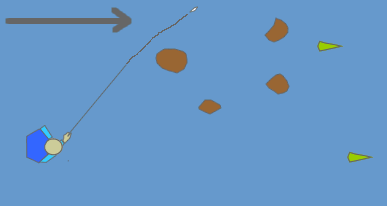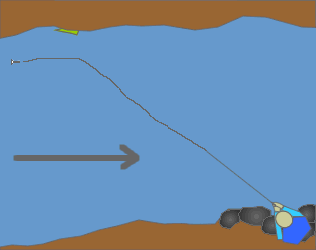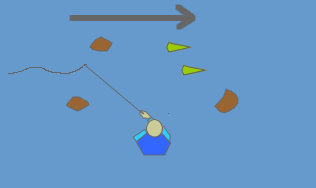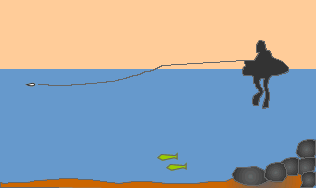

Streams | |||
Downstream Sweep | |||
 A Downstream Sweep is probably the most popular presentation of streamers on streams. Usually, it is used with Full Sink or Sink-Tip lines. Cast the streamer across and slightly downstream. As the streamer moves downstream, line drag will cause the streamer to sweep across the feeding zone of the fish. The fish are presented a broadside profile of the fly as the sweep is beng made. This will generally provoke a strike. Once the pattern is directly downstream, retrieve with quick strips and pauses. Use your rod tip to work the streamer back and forth within the current as you are retrieving the line. | |||
Downstream Retrieve | |||
 Baitfish will often move downstream when spooked. This presentation mimics that movement and is particularly good around undercut banks. Make a curve cast upstream close to the bank. Let the streamer sink and reach mend the line to get the streamer even closer to the bank. Strip in your line and move the rod tip downstream faster than the current. A sinking line works well in deep waters and medium currents. However, you can use a floating line when the current is slower and the water is more shallow. The upstream cast should give the streamer enough time to sink as it moves downstream. | |||
Dead Drift | |||
 The Dead Drift Presentation is made by casting upstream with a tuck cast and allowing the rod tip to move at the same speed downstream as the streamer at a 45 degree angle. The streamer will reach it's deepest position directly in front of you and will sweep upwards at the end of the swing due to drag. Try to keep the streamer off the bottom, it is not a nymph, but moving like a baitfish. Keep the slack to a minimum in order to respond to the strikes with a good opportunity for a hook set. Dead-Drifts are particularly good within pocket waters and deep riffles. | |||
Lakes | |||
Count and Retrieve | |||
 Count and Retrieve Presentation is the most common technique on lakes. The rate of descent will be based on the type of sinking line that you use. Apply an overhead cast and count the seconds of descent that you need to get to a certain depth. It is important that you have a knowledge of the depth of the bottom and what kind of bottom structure is there. In shallow lakes of less than 7 feet, there is most likely submerged weedbeds, and you will want to count only to the depth that your streamer will not get hung up in the weeds. Fish like to strike upwards and a slow descending line will often give you a good idea as to the depth of the feeding zone. A clear intermediate line is often a good choice since the line is less obtrusive than many of the other sinking lines. With streamers, many of your strikes are in the upper 4 feet of water and they are not subtle. The fish attack them as baitfish, very aggressively. There are a number or retrieval patterns to try: | |||
Types of Retrievals | |||
| |||
Trolling | |||
With a float tube you have the ability to move around. This gives you an opportunity to troll the streamer flies without retreiving. Trolling can be very helpfull in exploring a new lake , to cover a lot of water, and keep your fly in the water. Keep your rod tip down, even in the water, as this will give your a better direct contact of the fly to your stripping hand without any slack. | |||
Types of Actions | |||
| |||
Wind Drifting | |||
When the fishing is slow, wind drifting can be the ticket since the fish are too lathargic for an aggressive attack. The hits can be subtle, so react with a calm pull of the line for hook ups. Cast the streamer and let the wind blow the float tube through the lake. A full sinking line will maximize your depth and may work the best since lethargic fish tend to be within the deeper levels of the lake. Try Woolly Buggers, they work well with this technique. | |||